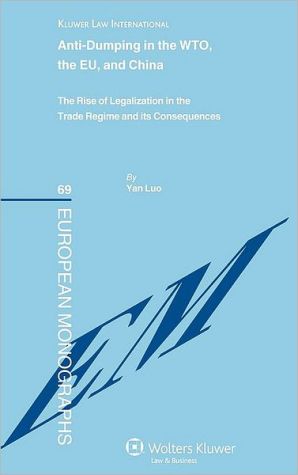Anti-dumping in the WTO, the EU and China. The Rise of Legalization in the Trade Regime and its Consequences
The process of 'legalization' in many issue areas of international politics.
Search in google:
With its virtually universal treaty network and its binding dispute settlement mechanism (DSM), has the World Trade Organization (WTO) become a 'legalized' international organization? To a large extent, the positive effect of the move to a higher
List of AbbreviationsForewordAcknowledgementsChapter 11 Introduction 1Chapter 2 Conceptualizing Legalization in the WTO System 71 Introduction 72 Defining Legalization in International Relations 102.1 Elements of Legalization 102.2 The Uneven Expansion of Legalization 132.3 Consequences of Legalization 172.4 A Richer View of Legalization? 173 Applying Legalization in the WTO System 183.1 Elements of Legalization in the WTO 183.2 Uneven Expansion of Legalization in the WTO 213.3 Consequences of Legalization in the WTO 253.3.1 'Legalizing' National Trade Policy in the GATT/WTO System 253.3.2 Building up Capacity to Utilize the DSM 273.4 Conclusion 30Chapter 3 Rise of Legalization in the Multilateral Framework 311 Introduction 312 Rise of Legalization in the Multilateal Framework 322.1 From Politics to 'Diplomat's Jurisprudence': The Evaluation of the GATT 322.1.1 Elements of Legalization in the GATT 322.1.1.1 Decision-making 332.1.1.2 Surveillance 342.1.1.3 Adjudication 352.1.2 Uneven Expansion of Legalization in the GATT 362.2 A New Hope of Legalization: The Establishment of the WTO 382.2.1 Decision-making 382.2.2 Surveillance 392.2.3 Adjudication 413 Theoretical Debates Related to Judicialization 423.1 The Role of the DSM 433.2 Standard of Review 463.3 Remedies and Compliance in the DSM 484 Conclusion 50Chapter 4 Legalization of Anti-dumping Rules at the International Level 531 Introduction 532 Phenomenon of Dumping and the Development of AD Laws 543 'Legalizing' AD Rules at the International Level 593.1 Trade Negotiations and International AD Rules 593.1.1 AD Negotiations in Pre-Uruguay Trade Rounds 593.1.1.1 GATT Article VI 603.1.1.2 GATT Report of Group of Experts (1961) 623.1.1.3 The Anti-dumping Code of Kennedy Round (the 1968 Code) 653.1.1.4 The Anti-dumping Code of Tokyo Round (the 1979 Code) 663.1.2 The Uruguay Round and the WTO Anti-dumping Agreement (ADA) 693.1.2.1 Legal Status of the ADA 703.1.2.2.1 An Overview 703.1.2.2.2 Obligation 733.1.2.2.3 Precision 773.1.2.2.4 Delegation 813.1.3 Anti-dumping in the Doha Round 843.2 Surveillance Mechanism and the AD Rules 883.3 Anti-dumping in the Dispute Settlement Mechanism 904 The Uneven Expansion of Legalization in the AD Regime 954.1 The Uneven Expansion of Obligation 954.2 The Uneven Expansion of Precision 1004.3 The Uneven Expansion of Delegation 1015 Conclusion 103Chapter 5 WTO-transposed and WTO-plus Features of the EU AD Regime 1051 Introduction 1052 WTO-Transposed Features of the EU Anti-Dumping Regime 1072.1 Evolution of Community AD Instruments 1072.1.1 Pre-ADA Community AD Instruments 1072.1.2 An Overview of Regulation 384/96 (the Basic Regulation) 1112.2 Administration of Community AD Rules 1162.2.1 The Commission and the Administration of AD Proceedings 1162.2.2 Control of Administration within the EU 1192.3 Judicial Review of Community AD Policy 1223 WTO-Plus Features of the EU Anti-Dumping Regime 1273.1 Injury Margin 1273.1.1 Lesser Duty Rule in the WTO 1273.1.2 Injury Margin Calculation in the EU 1303.2 Community Interest 1343.2.1 Public Interest in WTO Law 1343.2.2 Community Interest Test in the EU Law 1353.2.2.1 Procedural Aspects of the Community Interest Test 1363.2.2.2 Substantive Assessment of the Community Interest 1373.2.2.3 Reflections on Green Paper 1403.3 Anti-circumvention 1433.3.1 Anti-circumvention in the WTO 1433.3.2 Anti-circumvention in the EU Anti-dumping Law 1443.3.2.1 Change in the Pattern of Trade 1463.3.2.2 Practice, Process or Work 1473.3.2.3 Insufficient Due Cause or Economic Justification 1473.3.2.4 Remedial Effects of the Duty 1483.3.2.5 Like Product 1483.3.2.6 The 60% Value of Parts Test and the 25% Value-added Test 1494 Conclusion 150








